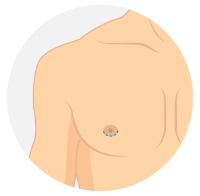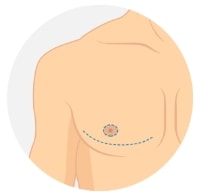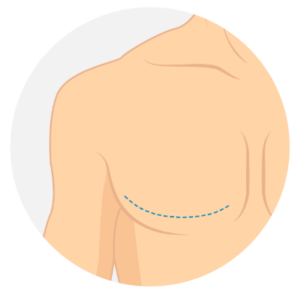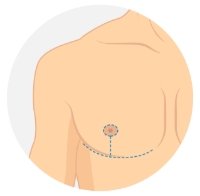Home|Breast Procedures|Top Surgery|Female to Male (FTM) & Female to Non-Binary (FTN) Top Surgery
Female to Male (FTM) & Female to Non-Binary (FTN) Top Surgery
Quick Facts About FTM & Gender Non-binary Top Surgery:
- Principal Benefits: Top surgery helps align chest appearance with gender identity, reducing dysphoria and improving self-confidence. It also offers freedom from binding and increased mental and physical comfort in daily life.
- Treatment Details: FTM and FTN top surgery is typically performed under general anesthesia on an outpatient basis.
- Procedure Overview: Top surgery involves removing breast tissue to create a chest that is aligned to each individual’s specific gender defined characteristics. This may be masculinized, androgynous or nonbinary along an almost infinite spectrum. Techniques vary based on factors such as chest size, skin elasticity and patient preferences including retaining or permanently removing the nipple-areola complexes. Dr. Turkeltaub will customize the treatment plan in order to suit your aesthetic and gender preferences.
- Recovery Timeline: Most patients can return to light activities within about one week. Drains will be placed to prevent fluid build-up and will remain for around 10-14 days. Complete recovery, without any physical restrictions whatsoever, may take 10 to 12 weeks. This will vary based on procedure and individual variables.
- Surgeon’s Experience: Dr. Turkeltaub has extensive experience working with transgender and gender non-binary patients. He and his professional staff provide skilled, compassionate, personalized, thorough and non-judgmental care for patients. He is also a member of the World Professional Association for Transgender Health (WPATH).
Feeling that the body you were born with does not match the innate sense of your true gender can be stressful, anxiety provoking and depressing. For those who are transgender or gender non-binary, your appearance as opposed to your gender identity do not align. Even if you think, behave, dress and interact with others in a way that feels authentic to you, certain gendered physical characteristics may continue to represent a source of discomfort or distress—resulting in a condition known as gender dysphoria.
For many individuals, gender dysphoria can lead to negative, destructive manifestations such as anxiety, depression, eating disorders, self-harm, substance abuse, anti-social behavior and even suicide. Counseling, psychological and psychiatric sessions can be very effective in helping people constructively address and deal with both gender identity issues and the associated negative behaviors. It can also help facilitate medical transition including gender affirming surgery where a person can ultimately bring their physical characteristics into better alignment with their gender identity.
Advancements in the field of gender affirming plastic surgery and the greater availability of these services have made it far easier for interested individuals to undergo these procedures, leading to results that can be extremely positive and life-changing. Here at the Arizona Center for Aesthetic Plastic Surgery, board-certified plastic surgeon Dr. Steven H. Turkeltaub specializes in transgender breast (top) surgery, including female to male (FTM) and female to non-binary (FTN) top surgery, helping his patients obtain tremendously desirable outcomes.*
Dr. Turkeltaub has been providing care to members of the transgender community for many years, and he strives to ensure that every interaction you have with him and his staff is professional, caring, helpful and supportive.
During your consultation with Dr. Turkeltaub, he will seek to understand your unique goals and desires. Then, based on your anatomy, he will customize a treatment plan to help you achieve your life-changing transformation.
Before you can undergo the selected breast procedure, however, we do require written documentation by a qualified mental health professional diagnosing your gender dysphoria, stating that you have met all criteria necessary to be considered an appropriate candidate for the surgery and supporting your desire to proceed with it.

We do follow the guidelines from the World Professional Association for Transgender Health (WPATH) Standards of Care. WPATH seeks to promote the highest possible quality of care for transgender and gender diverse individuals, championing respect, compassion and inclusivity, Dr. Turkeltaub has been a member of the organization for several years and he seeks to uphold these values throughout every facet of his practice.
*Genital reconstruction procedures are not offered.
- What Is Female to Male (FTM) Top Surgery?
- What is Female to Non-Binary (FTN) Top Surgery?
- Female to Male (FTM) and Female to Non-Binary (FTN) Top Surgery Techniques
- Female to Male (FTM) and Female to Non-Binary (FTN) Top Surgery Recovery
- Female to Male (FTM) and Female to Non-Binary (FTN) Top Surgery Patient Testimonials
What Is Female-to-Male (FTM) Transgender Breast Surgery?
Female to male (FTM) transgender breast surgery—also called FTM top surgery—is a gender affirming reconstructive procedure that transforms an anatomically female presenting chest into a more masculine appearing one that aligns with the individual’s actual gender identity. FTM top surgery is generally the first and, oftentimes, the only surgical treatment that transmen pursue as a part of their medical transition due to its efficacy in addressing chest-based gender dysphoria.
Changing a feminine chest anatomy to a masculinized form involves the removal of the breast tissue (mastectomy) along with any excess skin, possible nipple and areola modifications including size and position, and contouring of the chest wall. This is most often accomplished with the keyhole technique, the concentric circle (periareolar) approach or with the double incision free nipple graft technique (see below for more). Liposuction can also be used to further enhance the outcome. Other ancillary procedures may be desired in order to better align with one’s affirmed gender.
As with any surgical procedure, there are attendant risks that will be discussed during your consultation. With his extensive experience and meticulous techniques, Dr. Turkeltaub will do whatever he can in order to help you obtain the best possible results while also trying to prevent or minimize the chance of these untoward issues occurring.
What Is Female to Non-Binary (FTN) Top Surgery?
Gender non-binary or otherwise gender non-conforming patients (including agender, genderqueer and other gender diverse individuals) oftentimes have their own unique relationship with chest-based gender dysphoria. While many individuals seek a similar chest aesthetic to our FTM patients (a flatter, more masculine contour), others may be interested in having an aesthetic that is less traditionally binary in nature.
Dr. Turkeltaub is committed to providing compassionate and personalized care for his patients, and he will work closely with you in order to gain a better understanding of your top surgery goals. For instance, there is wide ranging variability as regards preferences for nipple-areola complex size, location and even whether or not they are even wanted. Whatever your preferences may be, Dr. Turkeltaub will help you achieve the results that you desire.

Female to Male (FTM) and Female to Non-Binary (FTN) Top Surgery Techniques
The incision pattern utilized to perform female to male or female to non-binary breast surgery depends on several factors. These include the pre-existing breast size, configuration, degree of skin laxity and excess, the size and location of the nipple-areola complexes, whether or not nipple-areola complexes are desired, patient preference and plastic surgeon recommendation and experience. The most common approaches include:

 Keyhole mastectomy – With this technique, a mastectomy (removal of the breast tissue) is performed through an incision involving the lower half of the areola, making the ultimate scar fairly inconspicuous. This is a good choice when the breasts are small and have good skin tone. If the areolas are large, they can be reduced in size at the same time by extending the incision around the whole areola and removing a “donut” of skin (see B).
Keyhole mastectomy – With this technique, a mastectomy (removal of the breast tissue) is performed through an incision involving the lower half of the areola, making the ultimate scar fairly inconspicuous. This is a good choice when the breasts are small and have good skin tone. If the areolas are large, they can be reduced in size at the same time by extending the incision around the whole areola and removing a “donut” of skin (see B).
 Concentric circle (periareolar) mastectomy – This is a variation of the Keyhole technique (see A) and is used when there is some excess skin present and/or a large areola that needs to be reduced in size. This approach involves the excision of a “donut” of skin of an appropriate width extending around the entire areola, either at its margin or within it (to reduce its size).
Concentric circle (periareolar) mastectomy – This is a variation of the Keyhole technique (see A) and is used when there is some excess skin present and/or a large areola that needs to be reduced in size. This approach involves the excision of a “donut” of skin of an appropriate width extending around the entire areola, either at its margin or within it (to reduce its size).

Double incision free nipple graft mastectomy – This approach involves a mastectomy along with the excision of an appropriately configured and amount of skin extending strategically placed on the breast mound. The nipple-areolar complexes are removed, reduced in size and then placed back in the appropriate location as full thickness skin grafts.
The double incision technique is commonly employed in patients who have a moderate to large amount of breast tissue and skin laxity. It is, in fact, the most common approach employed for FTM and FTN top surgery.


Double incision mastectomy without nipple-areola complexes – This is the same as the double incision free nipple graft mastectomy with the “only” difference being that the nipple-areola complexes are not put back on. They are permanently removed. This is a not an uncommon choice especially with our non-binary patients.


Inverted “T” mastectomy – This is the same configuration as that performed for most breast reduction procedures and involves an incision extending from around the areola then down to and along the crease at the lower part of the breast. With this technique, the nipple-areola complexes can either remain attached to underlying tissues or be removed and repositioned back as full thickness skin grafts.
Nowadays with the available options, there is essentially no reason to use this approach.
At the time of your consultation with Dr. Turkeltaub, the most realistic option(s) for your particular situation will be thoroughly discussed.
Female to Male (FTM) and Female to Non-Binary (FTN) Top Surgery Recovery
Following surgery, you will have a circumferential dressing on for a few days before being placed in an elastic, form-fitting garment for several weeks. Drains, which are placed at the time of surgery, are usually removed in the office after ten days to two weeks.
You can expect discomfort to be mild to moderate and it is usually well controlled with oral analgesics (painkillers) like Tylenol. Most patients can return to school or a non-strenuous job within several days to a week. Very vigorous activities, heavy lifting, certain sports and straining need to be avoided for around four weeks after surgery, and upper extremity activities should be minimized for a total of eight weeks. There will be some variation in these guidelines based on the specific technique employed as well as individual circumstances.
“How was your recovery time?” – Transgender Patient
The transformational results of your FTM or FTN breast surgery is apparent immediately. However, it can take up to a year for you to see what the final results will be as the swelling abates and the scars fade.
Female to Male (FTM) and Female to Non-Binary (FTN) Top Surgery Patient Testimonials*
*Individual Results May Vary
Are You Interested in FTM or FTN Breast Surgery?
If you are seriously considering Female to Male or Female to Non-Binary breast surgery, Dr. Turkeltaub would be very happy to assist you in making your goals a reality. To schedule your consultation, you can contact our practice either by phone at (480) 451-3000 or online.